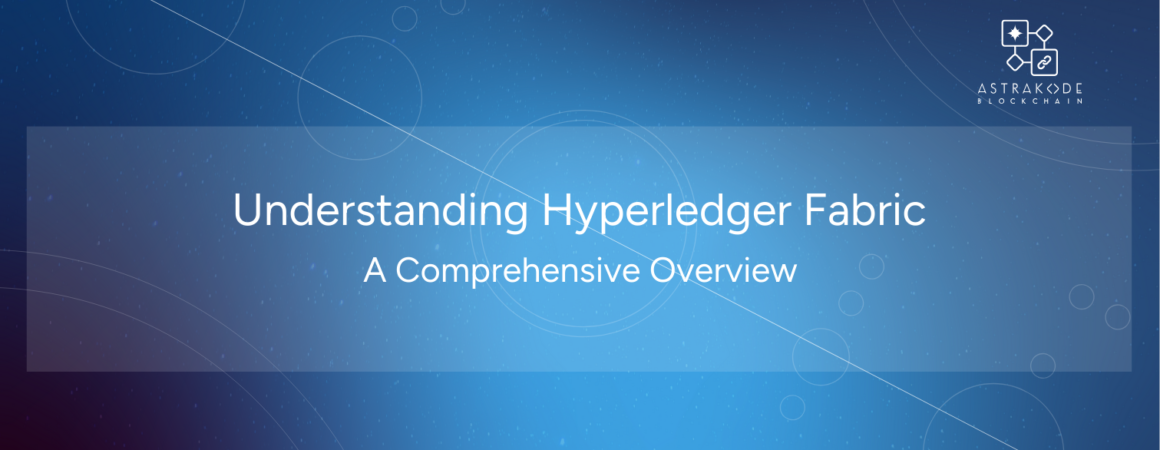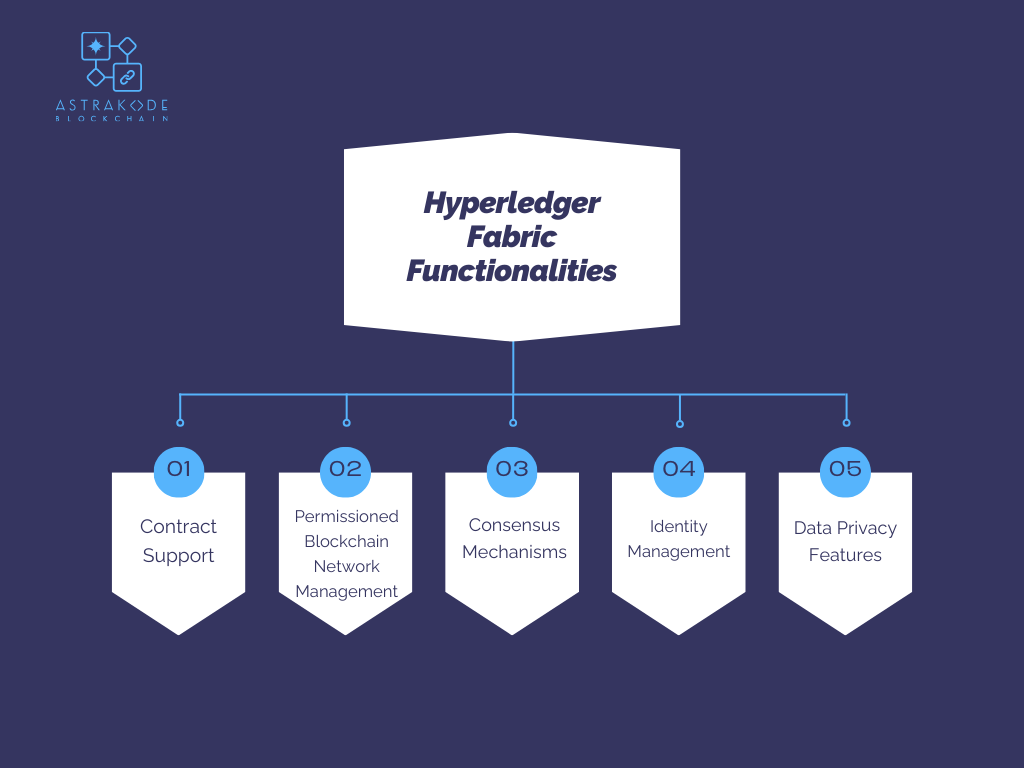Understanding Hyperledger Fabric: A Comprehensive Overview

When it comes to enterprise blockchain technology, hyperledger fabric stands out as one of the most popular and widely adopted platforms. Part of the larger hyperledger project portfolio under the Linux Foundation, hyperledger fabric is a blockchain framework designed for developing enterprise-grade applications and solutions. Offering a permissioned and modular architecture, hyperledger fabric empowers organizations to create secure, scalable, and customizable blockchain networks. With its focus on privacy, confidentiality, and performance, hyperledger fabric blockchain is the preferred choice for businesses looking to implement distributed ledger technology.
AstraKode’s AKB platform harnesses Hyperledger Fabric to offer enterprises a seamless blockchain development experience. Key features include the Network Composer for easy blockchain network setup, a versatile Smart Contract IDE supporting Hyperledger Fabric and Solidity, and automated tools for deployment, testing, and auditing to ensure top-notch reliability and security. AKB makes blockchain accessible for all business sizes, prioritizing efficiency and user-friendliness in blockchain solutions.
In this article, we will explore what hyperledger fabric is and why it has become a leading player in the hyperledger blockchain ecosystem and how astrakode will help you to leverage the technology.
What is Hyperledger Fabric?
Hyperledger Fabric is a permissioned blockchain platform tailored for the creation of private or consortium blockchain networks. This enterprise-grade platform offers a modular and highly customizable architecture, making it well-suited for diverse industry applications. Differing fundamentally from public blockchains, where participation and transactions are open to anyone, Hyperledger Fabric operates on an invitation-only basis. This selective participation model ensures a higher level of privacy and security, making Hyperledger Fabric an ideal choice for businesses and organizations. These entities often require a blockchain environment that supports specific operational needs while maintaining controlled access and confidentiality, characteristics that are critical in private or consortium settings as opposed to the open nature of public blockchains.
How does Hyperledger Fabric Work?
Hyperledger Fabric introduces a groundbreaking approach to how a blockchain can operate, emphasizing efficiency, privacy, and scalability. Here’s a breakdown of its operational model:
Permissioned Network
Unlike public blockchains, where anyone can join and participate, Hyperledger Fabric offers a permissioned setup. This means that every participant, or node, on the network is authenticated and authorized to play specific roles, enhancing security and trust among participants.
Smart Contracts and Chaincode
The business logic of Hyperledger Fabric applications is encapsulated in “chaincode” (the Fabric term for smart contracts). Chaincode allows for the automation of contractual agreements, with all terms directly written into lines of code. These smart contracts execute within the context of the blockchain, ensuring that all transactions are transparent and tamper-proof.
Pluggable Consensus Mechanism
One of the most distinctive features of Hyperledger Fabric is its pluggable consensus mechanism. This means that the network can adopt a consensus model that best fits its operational needs and trust model. Unlike the energy-intensive proof-of-work consensus used by some blockchains, Fabric’s approach is more efficient and adaptable, supporting a variety of algorithms based on the network’s requirements.
Channels for Privacy
Hyperledger Fabric addresses the need for privacy through “channels.” Channels allow for a subset of participants to transact privately, segregating the data from the wider network. This feature is particularly useful for businesses that need to keep certain transactions confidential among a select group of parties.
Ledger and The Ordering Service
At its foundation, Hyperledger Fabric maintains a distributed ledger that records all transactions across the network. The ledger consists of two parts: the world state (current value of the ledger) and the transaction log (history of all transactions). The ordering service bundles transactions into blocks and ensures their proper sequence before they are committed to the ledger, maintaining the integrity and consistency of the network.
Hyperledger Fabric Architecture
Now, let’s explore the Hyperledger Fabric architecture and its components that have positioned it as the best suite for enterprise needs. Each element plays a crucial role in enhancing the network’s security, scalability, and flexibility. This examination seeks to provide insights into how Hyperledger Fabric facilitates secure, transparent, and efficient digital transactions within the context of enterprise solutions.
Peers
The backbone of the Hyperledger Fabric network consists of peers, which are the fundamental elements that host ledgers and smart contracts (chaincode). These peers are responsible for maintaining the state of the ledger and processing transactions.
In Hyperledger Fabric, the network’s architecture includes two primary types of peers, each playing a pivotal role in maintaining the system’s integrity and confidentiality. The endorsing peers are responsible for executing chaincode, simulating transactions, and providing their endorsement. This process ensures that transactions are valid and adhere to the network’s agreed-upon rules before they are finalized. On the other hand, committing peers are tasked with committing the endorsed transactions to the blockchain, making them immutable and part of the ledger’s historical record.
This separation of duties between endorsing and committing peers is foundational to Hyperledger Fabric’s approach to scalable and secure transactions. By dividing these responsibilities, the network can efficiently process and validate transactions without compromising on security or performance. This design also supports the network’s capacity to handle a high volume of transactions while upholding strict confidentiality and integrity standards. Through this mechanism, Hyperledger Fabric achieves a balance between scalability and security, ensuring that all transactions are processed in a reliable and trustworthy manner.
Ordering Service
The ordering service is at the heart of Hyperledger Fabric’s architecture, playing a critical role in maintaining the consistency and reliability of the network. Its primary function is to batch transactions into blocks and distribute them to all peers on the network, ensuring a consistent transaction order. This service is vital for the decentralized consensus mechanism of Hyperledger Fabric, allowing it to support various consensus algorithms tailored to the network’s needs. The modular nature of the ordering service also enhances the platform’s flexibility, accommodating different scales and requirements of enterprise applications.
In traditional blockchains utilizing PoW, each node competes to solve complex mathematical puzzles, consuming substantial computational resources and time. This process, while securing the network, limits transaction throughput and scalability due to the high energy and time requirements for block creation.
Hyperledger Fabric’s ordering service, on the other hand, bypasses these limitations by centralizing the transaction ordering process. It batches transactions into blocks and then distributes them to all peers, ensuring a consistent transaction order across the network. This method eliminates the need for energy-intensive computations associated with PoW, leading to a more efficient transaction validation and commitment process.
Smart Contracts (Chaincode)
Hyperledger Fabric introduces a unique approach to smart contracts through chaincode. Chaincode encapsulates the business logic of the blockchain network, allowing developers to implement versatile applications directly on the blockchain. This feature not only automates contractual agreements but also enforces them in a secure and tamper-proof manner. Chaincode is pivotal for creating a transparent, efficient, and immutable system for executing and recording transactions, making Hyperledger Fabric a powerful tool for enterprise solutions.
Membership Service Provider (MSP)
Security and privacy are paramount in enterprise applications. Hyperledger Fabric addresses these concerns through the Membership Service Provider (MSP), which manages identities and enforces access controls within the network. The MSP ensures that all participants are authenticated and authorized, providing a secure and trustable environment for conducting transactions. This feature is particularly important for permissioned blockchains like Hyperledger Fabric, where network participants are known and vetted entities.
Hyperledger Fabric’s Membership Service Provider (MSP) not only fortifies security and privacy by managing identities and access within the network but also plays a crucial role in ensuring enterprises meet regulatory compliance. This aspect of MSP is vital for businesses navigating complex legal environments, providing a framework that aligns with regulatory standards while maintaining a secure, permissioned blockchain ecosystem.
Channels
Hyperledger Fabric introduces the concept of channels to provide privacy and confidentiality for transactions. Channels allow a subset of participants to create a private blockchain within the larger network, enabling them to conduct transactions securely and confidentially. This feature is essential for businesses that require privacy in their operations, allowing them to share sensitive information only with specific parties. Channels underscore Hyperledger Fabric’s commitment to providing flexible and secure blockchain solutions for enterprise applications.
For a deeper dive into the pre-configured components on AKB that speed up development, visit our AKB Wiki for more insights.
Hyperledger Fabric Transaction Flow
Transaction Proposal
It all starts with a client application sending a transaction proposal to a set of peers. Each peer executes the proposed transaction against a smart contract (chaincode) without updating the ledger. This process is critical for ensuring that the transaction is valid and can be executed as intended.
Endorsement
For a transaction to proceed, it must be endorsed by the specified peers, according to the endorsement policy defined for the smart contract. This policy specifies which peers must agree on the result of the transaction execution for it to be considered valid.
Ordering
Once endorsed, the transaction is submitted to the ordering service. This component collects endorsed transactions from all applications and orders them into blocks. The ordering phase ensures that transactions are sequenced correctly in the blockchain.
Validation and Commitment
The ordered blocks are then distributed to all peers in the network. Each peer validates the transactions against the endorsement policy and the current state of the ledger. Valid transactions are committed to the ledger, updating the blockchain state, while invalid transactions are discarded.
Hyperledger Fabric Functionalities
Hyperledger Fabric sets itself apart with its comprehensive suite of functionalities designed to meet the diverse needs of modern enterprises. These include:

Contract Support
At the foundation of Hyperledger Fabric’s capabilities lies its advanced contract support, realized through “chaincode.” Chaincode, Hyperledger Fabric’s version of smart contracts, allows businesses to encode the logic of their contractual agreements into the blockchain. This ensures that all transactions executed on the network are in strict compliance with the agreed-upon terms, automating enforcement and reducing discrepancies. Whether it’s automating payments, tracking the provenance of goods in a supply chain, or managing digital identities, chaincode facilitates a wide array of business processes.
Permissioned Blockchain Network Management
Hyperledger Fabric introduces a permissioned network model, a pivotal feature for enterprises concerned with privacy and security. Unlike public blockchains, where anyone can join and participate, Hyperledger Fabric allows organizations to control access to their network. This means that participants must be authenticated and authorized to engage in the network’s activities. This level of control not only enhances security but also ensures that sensitive business information remains confidential, accessible only to those with the right permissions.
Consensus Mechanisms
One of the most innovative aspects of Hyperledger Fabric is its flexible approach to consensus mechanisms. The platform does not prescribe a one-size-fits-all solution; instead, it offers a pluggable consensus framework. This allows organizations to select a consensus mechanism that best aligns with their operational needs and trust model. From simple, centralized approaches for small consortia to more sophisticated, decentralized methods for large networks, Hyperledger Fabric’s consensus mechanisms are designed to be adaptable and efficient.
Identity Management
Hyperledger Fabric excels in providing robust identity management features, essential for maintaining the integrity and security of the network. In Hyperledger Fabric, identities are verified and managed through the Membership Service Provider (MSP) by employing digital certificates issued by trusted Certificate Authorities (CAs). This system ensures that all participants in the network are authenticated and authorized to perform specific actions based on their roles. MSP can also integrate with existing corporate identity systems, leveraging standards like LDAP (Lightweight Directory Access Protocol) for identity verification. This integration allows for a seamless and secure connection between an organization’s identity management protocols and the blockchain, enhancing compliance and operational efficiency.
Data Privacy Features
In addition to its other functionalities, Hyperledger Fabric offers advanced data privacy features, ensuring that sensitive information is shared only among authorized parties. Channels and private data collections enable subsets of participants to engage in private transactions, with the assurance that their data remains confidential. This is particularly useful in scenarios where businesses need to collaborate without exposing competitive information to the entire network.
Benefits of Using Hyperledger Fabric
Increased Efficiency and Speed
Thanks to its permissioned nature and efficient consensus mechanism, Hyperledger Fabric significantly reduces transaction times and enhances overall network performance. This increase in efficiency is crucial for businesses that require high throughput and fast transaction processing.
Improved Security and Privacy
Hyperledger Fabric’s architecture is designed with security and privacy at its core. The permissioned network model, along with features like channels and private data collections, ensures that sensitive information is protected and only accessible by authorized parties.
Scalability
The modular design of Hyperledger Fabric allows businesses to scale their blockchain solutions as their needs grow. Whether it’s expanding the network with more participants or integrating additional functionalities, Hyperledger Fabric provides a solid foundation for growth.
Versatility
Hyperledger Fabric’s flexibility makes it suitable for a wide array of industry use cases, from supply chain management and trade finance to healthcare and digital identity verification. Its ability to be customized for specific business requirements makes it a powerful tool for innovation.
Reduced Complexity and Costs
Hyperledger Fabric’s simplified consensus process, which avoids the need for cryptocurrency, significantly lowers operational complexities and costs. This approach contrasts with public blockchain networks, which often require significant computational resources and energy consumption for consensus mechanisms like Proof of Work (PoW). Hyperledger Fabric’s efficient consensus models, such as Practical Byzantine Fault Tolerance (PBFT), streamline network operations, reducing the need for extensive computational power and thereby lowering costs for businesses.
Industry case study for Hyperledger Fabric: The Case of Systema
Systema S.r.l., an Italian IT consulting and software development company, specialized in document management for Building Information Modeling (BIM) projects, was in search of a solution to enhance the security and efficiency of their document sharing system. Their challenge was to establish a secure, manageable, and exclusive platform for companies to upload, share, and download critical project documents without compromising on privacy or data integrity. Traditional document management systems fell short, leaving Systema in need of a more robust, secure, and customizable solution.
Our collaboration with Systema S.r.l. focused on tackling their security concerns head-on by leveraging our platform’s capability to create customized private blockchain networks. By utilizing the Hyperledger Fabric architecture, we designed a bespoke blockchain solution tailored specifically to Systema’s needs. This innovative approach involved creating a separate channel for each of Systema’s clients, ensuring a private and secure communication pathway for document management between the service provider and each client. This modular design not only elevated the security of document exchanges but also introduced an unprecedented level of control and privacy into their operations.
Our solution effectively addressed Systema’s problem by eliminating the vulnerabilities associated with conventional document management methods. The implementation of a private blockchain transformed their document management system into a secure, efficient, and scalable platform. This change not only safeguarded sensitive project information against unauthorized access but also positioned Systema S.r.l. as a leader in secure document management for BIM projects, showcasing the potential of blockchain technology in solving real-world business challenges.
Read the full case study here.
Conclusion
At Astrakode, we see Hyperledger Fabric as a pivotal force in transforming enterprise blockchain applications. Its permissioned nature, modular architecture, and comprehensive functionalities cater to the specific needs of businesses, ensuring privacy, scalability, and efficiency. As we harness this open-source platform, our focus is on creating innovative solutions that streamline operations, enhance transparency, and foster trust across various industries.
Our platform embodies the ease and speed of development, ensuring that businesses can harness the full potential of Hyperledger Fabric without the complexity traditionally associated with blockchain technologies. Explore how we’re making blockchain development more accessible and efficient for everyone at our platform.
Try AstraKode today, It’s free!



